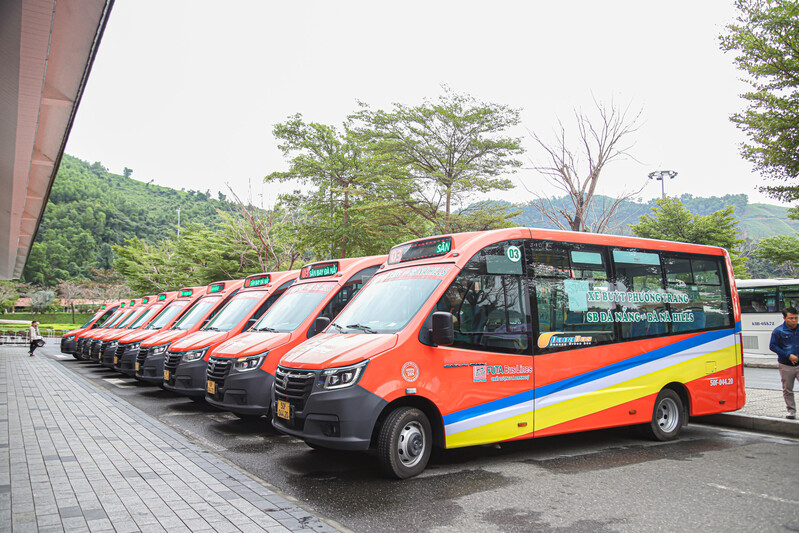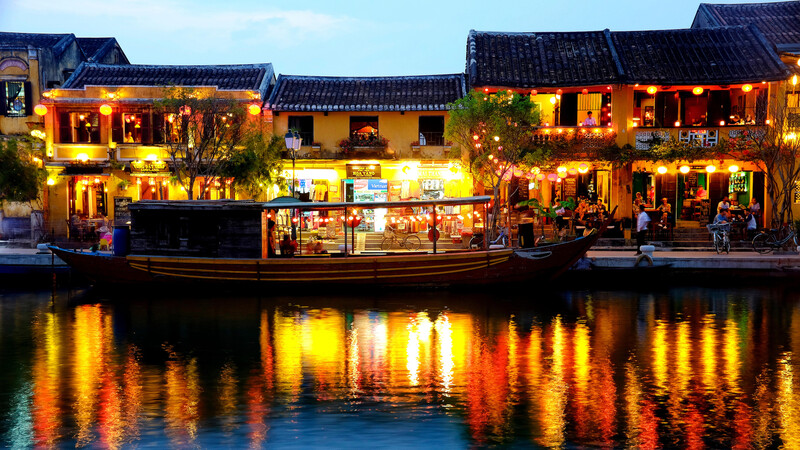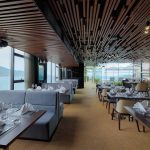Minh Mang Tomb in Hue is one of the 7 royal tombs built during the Nguyen Dynasty, recognized by UNESCO as a World Cultural Heritage site. To have a complete and meaningful trip to Minh Mang Tomb, make sure to save the information in this article!
Table of Contents
Where is Minh Mang Tomb located?
Minh Mang Tomb is located on Cam Khe Mountain, in Huong Tho Commune, Huong Tra Town, Thua Thien Hue Province. According to statistics, there are up to 40 different large and small constructions on this hill. Among them, Minh Mang Tomb is located in a convenient location, with cool mountains, rivers, and lakes. Although it is a solemn architectural work, it quickly became a popular destination for tourists near and far to visit and explore.
- Address of Minh Mang Tomb: National Highway 49 – Huong Tho – Huong Tra – Thua Thien Hue
How to Get to Minh Mang Tomb in Hue
Minh Mang Tomb is located about 12 km from the center of Hue, making it very convenient for tourists to visit. The route to the tomb is straightforward and easy to find. You can travel by one of the following routes:
- Route 1: From the city center of Hue, you can take a taxi or rent a motorbike, follow National Route 49 along the Huong River to Tuân Bridge. After that, continue straight for a bit, and you will reach the tomb of King Minh Mang.
- Route 2: Take a dragon boat upstream along the Huong River, following the two streams of Tả Trạch and Hữu Trạch, and you will arrive at the tomb.
Depending on the route chosen, you can select the appropriate mode of transportation, such as:
- Motorbike: Hue’s weather is pleasant, so you can easily plan your trip by renting a motorbike and navigating your way to the tomb. You can rent a motorbike directly from your hotel or from rental agencies, which you can find through Google or Facebook. The rental price ranges from 80,000 VND to 150,000 VND per day.
- Private Car: Renting a private car with a driver is a popular choice among many tourists due to its convenience and comfort. It also allows you to visit more attractions. Additionally, it is a budget-friendly option for groups. You can easily book a private car rental with a driver in Hue through VnCarRentals.com for the most comfortable trip.
- Taxi: Another way to get to Minh Mang Tomb is by taxi. Although the tomb is located in a hilly area, the road has been well-maintained for years, making it suitable for all types of vehicles. You can use ride-hailing apps to avoid high prices while ensuring a safe trip.
- Xe Om (Motorbike Taxi): If you’re not confident in driving on hilly roads but prefer not to take a taxi, you can opt for a xe om (motorbike taxi). You can also use ride-hailing apps to book a xe om
The history of the formation of Minh Mang’s tomb in Hue
Purpose of building Minh Mang’s tomb
Minh Mang was the second son of King Gia Long, known for his intelligence, wisdom, strong will, and strict upbringing. After his father’s death in 1820, he was crowned as king and took charge of the country’s affairs. During his reign, he made many important contributions to the country’s reforms, leading to the strong development of Dai Nam.

At that time, King Minh Mang wanted to build a tomb for himself with the initial purpose of creating a place to rest and relax after the stresses of ruling, and later as a final resting place.
The process of building Minh Mang’s tomb in Hue
To create the grand and beautiful Minh Mang’s tomb complex as it is today, a significant amount of time was spent choosing the location for construction. The court officials spent 14 years searching and researching before deciding on Cam Khe Mountain due to its combination of water, mountain, and greenery. The king then renamed the mountain to Hieu Son and named the tomb Hieu Lang.
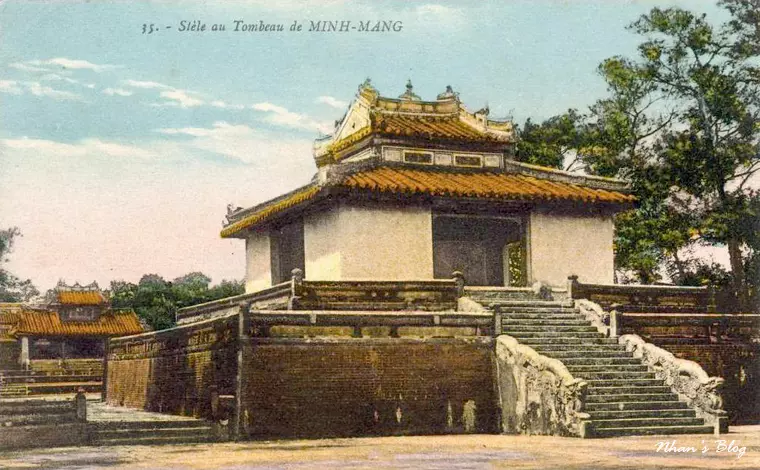
Because it was a meaningful project in his life, Minh Mang paid attention to every detail of the construction process. The architectural designs and reports were carefully reviewed and approved by the king. Construction began in 1840, and the king ordered all court officials to dig the lake to meet the schedule. However, after one disappointment, he demoted the overseeing officials. Unfortunately, before construction could continue, King Minh Mang became ill and passed away.
One month later, King Thieu Tri ascended the throne and continued the construction of La Citadel. In 1841, Minh Mang’s remains were buried in Buu Thanh, and it was not until 1843 that the tomb was officially completed.
Minh Mang’s tomb embodies a philosophy of life that few people know about.
Also known as Hieu Lang, Minh Mang’s tomb elicits unique sensations in almost all visitors. Here, one can appreciate the harmonious beauty, tranquility, and hidden vitality. Visiting Minh Mang’s tomb is not a mournful experience but a purification and rebirth between life and death.
One can sense that King Minh Mang was serene and wise in the face of death. Influenced by the Lao-Tzu and Confucian philosophies, he believed that “only humans are conscious of themselves and the universe, therefore, able to choose their relationship with nature. Sometimes it is harmony with nature, other times it is conquering, controlling, or exploiting nature.”
In his view, death is not the end but a transition to a new world filled with happiness and beauty. Thus, he sought out good land to create a paradise on earth, a poetic and musical destination where death is absent.
Minh Mang’s tomb embodies the harmony between humans and nature, creating a gentle soul. Visitors are impressed by the tomb’s beauty, which paints a beautiful landscape with a good philosophy.
Minh Mang Tomb in Hue preserves a treasure trove of Vietnamese literature.
The poetry of Minh Mang is intimately connected with the lives and aspirations of ordinary people, making the tomb of King Minh Mang a museum of enduring poetry that many seek out. The poetry of Minh Mang is inscribed on the Thai Hoa Palace, the Nine Dynastic Urns, and most notably on the Minh Mang Tomb.
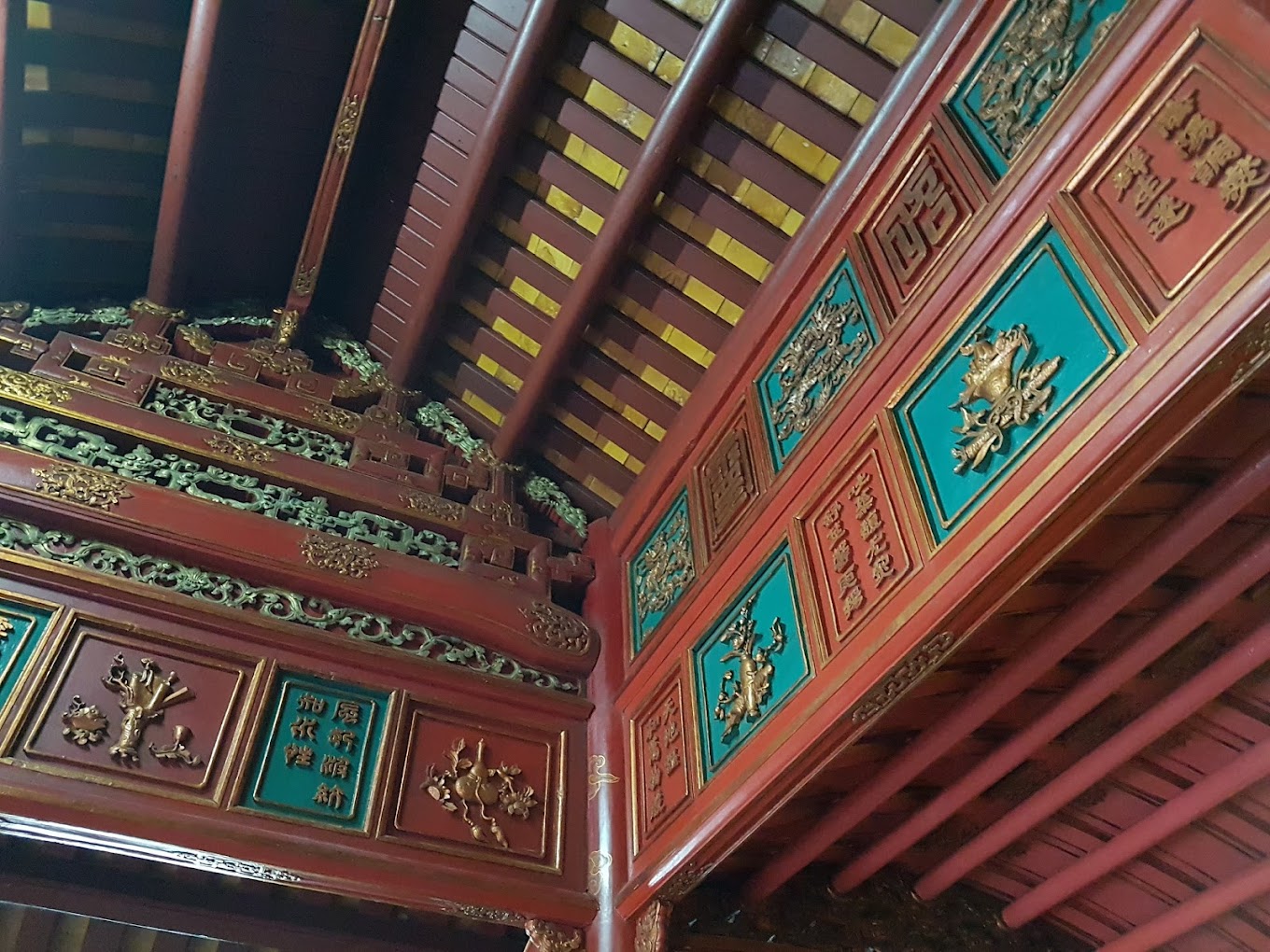
The total number of poems amounts to 120 quatrains, which are inscribed into 500 separate panels. All of the poems are divided and inscribed into separate panels and strips of three lines each on four main structures: Bi Dinh, Hien Duc Gate, Sung An Palace, and others.
All of the poems were written by King Minh Mang himself, but he did not consider himself a poet: “The poetry I write is only for leisure and entertainment.” If you have the opportunity to visit here, be sure to explore the wonderful poetry inscribed on the tomb.
Famous Check-in Spots at Minh Mang Tomb
With a total of 40 large and small architectural structures, it’s impossible to explore the entire Minh Mang Tomb in just one day. Instead, visitors can check out the following 7 standout attractions:
Dai Hong Mon(Great Red Gate)
Dai Hong Mon is the main gate before entering the Minh Mang Tomb. The gate is built with lime brick and features three passages. It has a unique decorative design, including koi fish transforming into dragons, along with beautiful dragon clouds (long van). Visitors can only enter through the left and right gates. It is said that the main gate was only opened once when the coffin of King Minh Mang was brought in. Since then, the gate has remained closed.
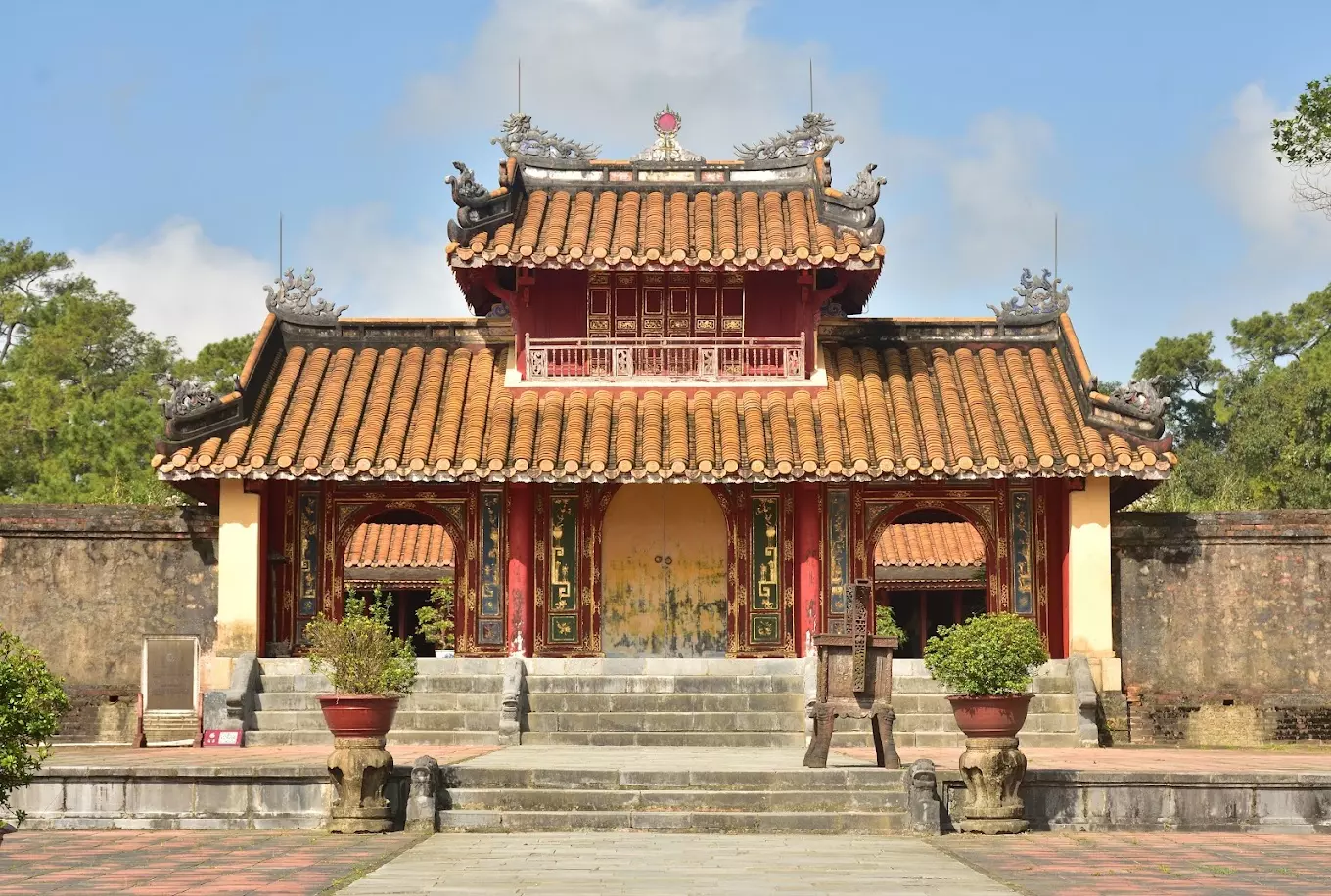
Bai Dinh
Passing through Dai Hong Mon (Great Red Gate) is Bai Dinh. True to its name, “Bai” means to pay respects, and “Dinh” refers to a courtyard. Bai Dinh is a large courtyard where visitors can pay respects or perform ceremonies before entering the tomb. On both sides of the courtyard, there are rows of statues of civil and military officials, along with pairs of stone elephants and horses standing as guards. The highlight of this area is the Thánh Đức Thần Công Stone Stele. This stone stele was inscribed by King Thieu Tri to commemorate the biography and merits of his father, King Minh Mang.

The Temple area of Minh Mang’s Tomb
This is the place to worship the king, including Hieu Duc Mon and Sung An Palace located in the center of the king’s worship area, queen, and Hoang Trach Mon. When you step in, you will immediately feel the sacred and ancient space, completely different from the surrounding areas. However, you will also enjoy the beauty of nature, such as the green of trees, the vast lake, and small lotus towers.
Minh Lau Tower in Minh Mang’s Tomb
Next is the Minh Lau Tower – a 2-story, 8-roof square building located on the Tam Dai Son hill, behind the Tho Chu flower garden. In the Minh Mang’s Tomb complex, this is the space for the king to rest, relax, and enjoy life. Perhaps that is why it is decorated so beautifully. In the bright sunshine, the rows of green trees are lush, and at night, you can easily admire the moon and feel the breeze. Note to visitors: do not litter or deface the artifacts!

Tam Dien Area
The Tam Dien area includes Hien Duc Mon, the entrance gate, and Dien Sung An, the main hall. This area is where the memorial tablets of the king and the Empress Ta Thien Nhan Hoang Hau are enshrined. The predominant colors inside the hall are the brown of the wood and the striking yellow, which symbolize the imperial rank. Here, visitors can experience a sacred and ancient atmosphere.

Note: Tam Dien refers to the sacred hall area within the Minh Mang Tomb complex, where the royal memorials are placed.
Tan Nguyet Lake
Next is the Tan Nguyet Lake area, which features a crescent-shaped pond. The shape of the pond resembles the symbol of the new moon embracing the sun, represented by Buu Thanh. This design reflects the harmony of yin and yang, symbolizing the balance and transformation of all things according to the principles of feng shui.
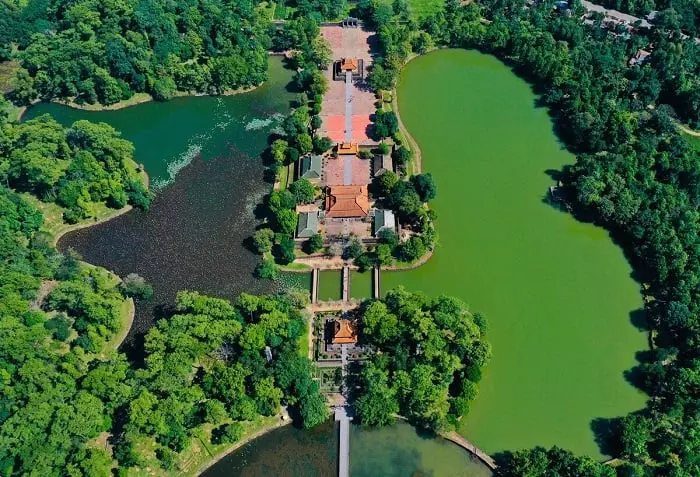
Note: Tan Nguyet Lake refers to the crescent-shaped pond within the Minh Mang Tomb complex, reflecting the philosophical and spiritual significance of balance in nature.
The Thong Minh Chinh Truc Bridge inside the mausoleum
Spanning over Tan Nguyet Lake is Thong Minh Chinh Truc Bridge. Visitors must cross this bridge to reach Lau Minh Lau. The bridge is built in ancient architectural style, consisting of 33 steps that lead directly from the entrance to the Lau Minh Lau tower.
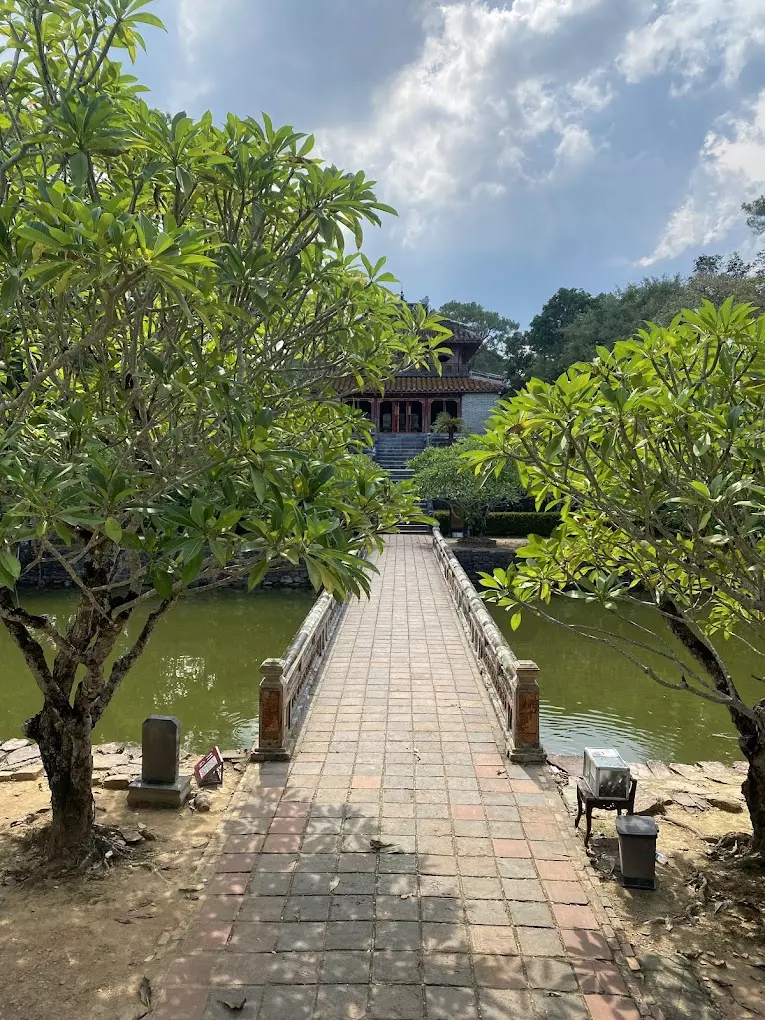
Note: Thong Minh Chinh Truc Bridge refers to the bridge within the Minh Mang Tomb complex, symbolizing the transition from the entrance to the elevated tower.
The latest ticket prices and visiting hours for Minh Mang Tomb in 2025
Currently, the ticket price for visiting Minh Mang Tomb in Hue is 100,000 VND/adult, 50,000 VND/seniors and children, and 20,000 VND/ride for children. The tomb is open to visitors every day of the week, from Monday to Sunday (from 7 am to 5:30 pm). Tourists can plan their visit to this revered king’s tomb at their convenience.
You can check the ticket prices for Minh Mang Tomb and all other tourist attractions in Hue in this article: Ticket price to visit Hue Updated
Visiting Minh Mang Tomb in Hue Experience
When is the best time to visit Minh Mang Tomb in Hue?
The most pleasant weather in Hue is around January and February. This is the beginning of spring, with cool weather, not too sunny and no rain, making it convenient for travel and visiting historical sites. Absolutely avoid going during the rainy season, as the rainy season in Hue usually lasts for a long time, and can even be quite cold!
How long does it take to explore the entire Minh Mang Tomb complex?
The architectural complex of the tomb is quite extensive. If you want to explore all the nooks and crannies inside and around the tombs and historical relics, you will need about 3 to 4 hours.
You can refer to our Hue City tour from Da Nang. It is a day trip with a flexible itinerary that you can customize according to your preferences.
Notes when visiting Minh Mang Tomb in Hue
When entering the tomb of a once noble king, you should be aware of some rules to avoid unpleasant situations and ensure a smooth trip:
- Clothing: It is recommended to wear modest and respectful attire. Avoid wearing revealing clothes or outfits with bold, unconventional designs. Since the tomb is a sacred site, we should wear neat and respectful clothes to show our reverence.
- Speech: Similarly, when visiting a sacred place, pay attention to your words. Avoid making noise or speaking disrespectfully. Try to be polite, move quietly, and speak softly to avoid disturbing the peaceful environment where the king rests.
- Follow the regulations of the management: To preserve the architecture and historical relics in their original state, pay attention to the rules set by the management, such as not climbing, touching forbidden artifacts, or damaging statues and sacred objects.
- Maintain cleanliness: Be conscious of keeping the tomb area clean. You may rest and recharge during your exploration, but after eating or drinking, make sure to dispose of your trash in the designated bins provided by the management!
The tomb of Minh Mang is a significant historical site that reflects the society of a bygone era. If you have the opportunity to visit Hue, do not miss this destination to witness its grandeur and learn about its deep historical values.
